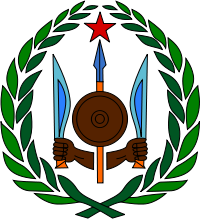- Coat of arms of Djibouti
-
The national emblem of Djibouti was introduced after attaining independence from France on 27 June 1977. It is bordered on the sides with laurel branches. Within this perimeter there is a vertical spear, in front of which is a shield. Underneath the shield, two hands rise away from the spear, both of which carry a large machete. These two hands symbolize the main two ethnic groups of the nation: the Afar and the Issa. The spear is topped by a red star.The star symbolizes the unity between the Issa and the Afar peoples.
Coats of arms and emblems of Africa Sovereign
states- Algeria
- Angola
- Benin
- Botswana
- Burkina Faso
- Burundi
- Cameroon
- Cape Verde
- Central African Republic
- Chad
- Comoros
- Democratic Republic of the Congo
- Republic of the Congo
- Côte d'Ivoire (Ivory Coast)
- Djibouti
- Egypt
- Equatorial Guinea
- Eritrea
- Ethiopia
- Gabon
- The Gambia
- Ghana
- Guinea
- Guinea-Bissau
- Kenya
- Lesotho
- Liberia
- Libya
- Madagascar
- Malawi
- Mali
- Mauritania
- Mauritius
- Morocco
- Mozambique
- Namibia
- Niger
- Nigeria
- Rwanda
- São Tomé and Príncipe
- Senegal
- Seychelles
- Sierra Leone
- Somalia
- South Africa
- South Sudan
- Sudan
- Swaziland
- Tanzania
- Togo
- Tunisia
- Uganda
- Zambia
- Zimbabwe
States with limited
recognition- Sahrawi Arab Democratic Republic
- Somaliland
Dependencies and
other territories- Canary Islands / Ceuta / Melilla / Plazas de soberanía (Spain)
- Madeira (Portugal)
- Mayotte / Réunion (France)
- Saint Helena / Ascension Island / Tristan da Cunha (United Kingdom)
- Western Sahara
Categories:- National symbols of Djibouti
- National emblems
- Djibouti stubs
- Heraldry stubs
Wikimedia Foundation. 2010.

